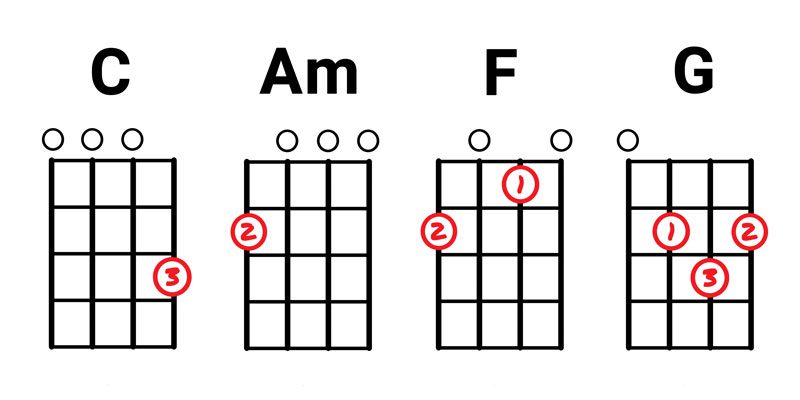The ukulele, with its charming sound and manageable size, has been captivating musicians and enthusiasts alike for generations. Whether you’re drawn to its cheerful strumming or its portability, the ukulele offers a delightful gateway into the world of music. For beginners, mastering a few fundamental chords is the key to unlocking a treasure trove of melodies. Let’s delve into some essential ukulele chords for beginners, igniting your journey into this enchanting instrument.

Embrace the Basics: C, G, Am, F
- C Chord: Often the first chord beginners encounter, the C chord sets the foundation for many songs. To play it, place your third finger on the third fret of the first string.
- G Chord: This chord adds a lively bounce to your strumming. Place your second finger on the second fret of the third string, your first finger on the second fret of the first string, and your third finger on the third fret of the second string.
- Am Chord: The Am chord introduces a melancholic yet beautiful tone. Position your second finger on the second fret of the fourth string.
- F Chord: While initially challenging for beginners, the F chord is worth mastering. Place your index finger across the first fret of both the second and fourth strings, then add your second finger to the second fret of the third string and your third finger to the third fret of the first string.
Progressing Further: D, Dm, A, E
- D Chord: With its bright and cheerful sound, the D chord is a popular choice for many songs. Position your second finger on the second fret of the fourth string, your third finger on the second fret of the third string, and your first finger on the second fret of the second string.
- Dm Chord: The Dm chord offers a subtle shift in mood, adding depth to your repertoire. Hold down the second fret of the third string with your second finger and the first fret of the second string with your first finger.
- A Chord: Another cornerstone chord, the A chord, is simple yet versatile. Place your first finger on the first fret of the third string.
- E Chord: Though it may initially feel challenging due to the stretch, the E chord opens up a myriad of musical possibilities. Position your first finger on the first fret of the fourth string, your second finger on the second fret of the third string, and your third finger on the second fret of the first string.
Practice Makes Perfect
As with any skill, consistent practice is key to mastering ukulele chords. Start by practicing each chord individually, ensuring clarity and accuracy in your fretting hand. Gradually, transition between chords smoothly, paying attention to the sound produced with each strum. and you might get to play as good as https://en.wikipedia.org/wiki/Israel_Kamakawiwo%CA%BBolehttps://en.wikipedia.org/wiki/Israel_Kamakawiwo%CA%BBole
Resources for Growth
Numerous online tutorials, chord charts, and instructional videos are available to aid beginners in their ukulele journey. Additionally, joining a local ukulele group or enrolling in lessons can provide valuable guidance and camaraderie.
Conclusion
Embarking on your ukulele journey as a beginner is an exciting adventure filled with discovery and musical exploration. By familiarizing yourself with these essential chords and committing to regular practice, you lay a solid foundation for further musical growth. So, strum away, and let the melodies of the ukulele accompany you on your musical voyage.